Small Evergreen Trees (With Pictures) – Identification Guide
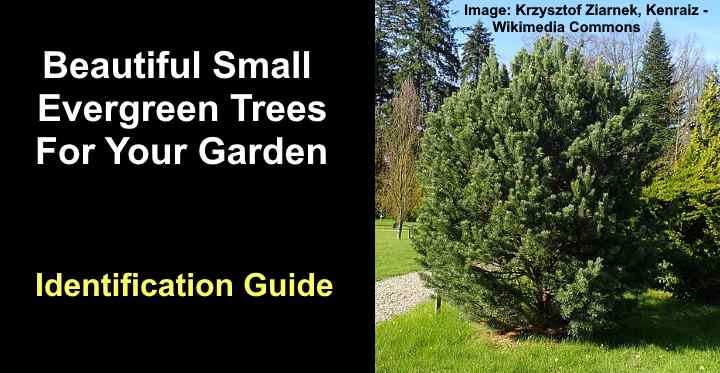
Small evergreen trees are perfect for adding year-round color and texture to your garden landscape without taking up too much space. Evergreen trees that don’t grow too tall are ideal for compact gardens, front yards, or accent plants in larger landscapes. With their evergreen foliage, small conifers and other evergreen trees provide a constant presence in your garden. Some evergreen trees under 10 feet tall also have fragrant flowers or colorful fruit.
Small pine trees are some of the most popular evergreen trees for landscaping small front or backyards. Other evergreen trees that don’t grow too tall include yew, spruce, cypress, juniper, and magnolia trees. Many of the best trees for small gardens have a slow growth rate, meaning they won’t get too big over time.
This article is an identification guide for small evergreen trees you can plant in various landscapes. Descriptions and pictures of the short evergreens will help you choose the best species for your yard. You’ll also learn how to use the small evergreen to landscape a compact garden.
Why Plant Small Evergreen Trees in Your Garden?
Small evergreen trees are an excellent addition to any small garden. Evergreen trees under 10 feet tall bring year-round color and texture to your outdoor space. Typically, small evergreens require little maintenance, are relatively drought-tolerant, and thrive in a wide range of soil conditions.
The greatest benefit of planting low-growing evergreen trees is their year-round colorful foliage. This helps to keep your front or backyard green throughout the year. Additionally, you can plant evergreen trees together to create a living screen for privacy and security around your garden. This dense natural barrier helps to block out any unwanted views and noise.
Small evergreen trees are an excellent investment for any garden, regardless of size. They offer a range of benefits, from low maintenance to year-round color, attractive landscaping and provide valuable habitats for wildlife.
With their versatility and beauty, small evergreen trees will surely add style, beauty, and appeal to any outdoor space.
How to Choose Small Evergreen Trees for Landscaping
When selecting small evergreen trees for your yard, it’s important to consider the best species for your climate, sun exposure, and soil conditions. Many species of conifers thrive in USDA growing zones 4 to 9. At the same time, some small evergreen flowering trees like dwarf magnolias add a pop of color and heavenly fragrances in subtropical and tropical climates.
The best small evergreen trees for small garden landscaping are conifers. These dense needle-like leaves or soft, scaly leaves retain color throughout the year. Therefore, unlike deciduous trees, they are ideal for low-maintenance gardens because there is no fall mess to clear up. This means that small evergreen trees are ideal for creating a vibrant backdrop for your garden or security fence.
Small Evergreen Trees for Landscaping (With Pictures)
Please continue reading to learn about some of the most popular small evergreen trees for landscaping compact gardens. From fragrant flowering evergreen trees to colorful conifers, here are some of the best low-growing evergreens to add year-round beauty and texture to your yard.
Small Mugo Pine Tree (Pinus mugo)

Mugo pine is a small evergreen tree with a shrubby growth that is a great choice for landscaping compact gardens
Mugo pine is a small evergreen tree for landscaping small gardens and backyards because it grows 3 to 5 ft. (1 – 1.5 m) tall and wide. The dwarf, evergreen mugo pine tree features dense, bushy needle-like leaves that grow in clusters and have a dark green color. The slow-growing pine tree produces small seed cones that add to its ornamental value.
Small mugo pine trees are ideal for planting as a specimen plant, in rock gardens, or as a low hedge. Growing along a foundation line, its slow growth and short stature mean it won’t block views from your windows.
Small mugo pine thrives in plenty of sun and well-drained soil.
The drought-tolerant Mugo pine tree is suitable for growing in USDA zones 2 to 7.
Small Scots Pine Tree (Pinus sylvestris ‘Watereri’)
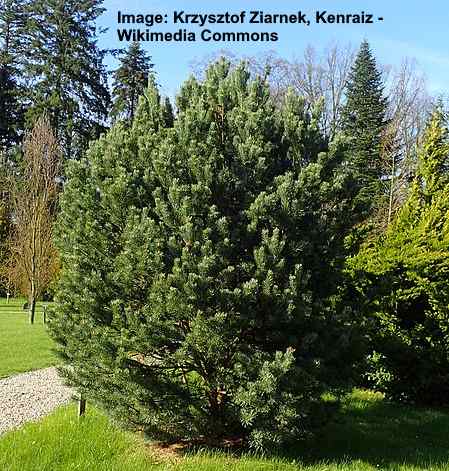
The cold hardy ‘Watereri’ Scots pine is a small evergreen conifer tree with attractive foliage
The small Scots pine tree is a hardy evergreen tree that grows around 10 feet (3 m) tall. This slow-growing ornamental tree has a conical shape and features bluish-green or silvery-gray needles that grow in pairs. The small evergreen conifer tree produces small, twisted pine cones, adding to its decorative appeal.
The small Scots pine tree eventually grows 10 ft. (3 m) tall and 10 ft. (3 m) wide. You can plant the tree as a specimen tree, a small landscape tree, or a windbreak.
The small conifer tree tolerates cold, drought, and poor soil when growing in full sun or partial shade. However, it prefers moist soil with good drainage.
The small Scots pine tree is suitable for growing in compact gardens in USDA zones 4 to 9.
Chalet Swiss Stone Pine (Pinus cembra ‘Chalet’)
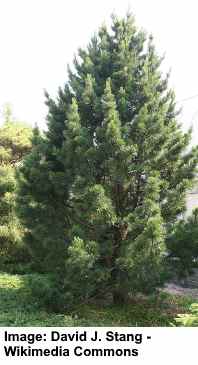
The evergreen Chalet Swiss stone pine has a narrow conical growth habit
Chalet Swiss stone pine is a slow-growing, small conical evergreen tree that grows under 10 feet tall. Also called the arolla pine, its narrow conical shape and soft, blue-green needles add a unique touch to any compact garden landscape.
The ornamental Chalet Swiss stone pine tree has a dense, pyramidal form. It grows 5 to 8 ft. (1.5 – 2.4 m) tall and 4 ft. (1.2 m) wide.
Other ornamental features of the small columnar tree are its short, blue-green needles that grow in pairs and small oblong woody cones that are 2” (5 cm) long.
Chalet Swiss stone pine grows best in full sun and well-drained soil. It is an excellent choice for small gardens, rock gardens, and as a specimen plant. The tree also makes a great addition to a winter garden, as a focal point near doors or entrances, or to add a vertical accent in tight spaces.
Chalet Swiss stone pine is suitable for growing in USDA zones 3 to 7.
Small Eastern White Pine (Pinus strobus ‘Nana’)

The slow growing Pinus strobus ‘Nana’ is a small evergreen conifer tree with rounded growth
The Eastern white pine cultivar ‘Nana’ is a compact, slow-growing evergreen tree, perfect for compact garden landscapes. The eastern white pine is identified by its silvery blue-green needles, dome shape, irregular branching habit, and long, slender, cylindrical, woody cones measuring 3” to 6” (7.5 – 15 cm) long.
The small eastern white pine is a slow grower and takes ten years to grow 2 to 3 ft. (0.6 – 1 m) tall and wide. The small, rounded tree is ideal for planting in small gardens, patios, or as a container plant. The tree thrives in full sun and well-drained soil and is drought-tolerant once established.
Small Eastern white pine is suitable for planting in USDA zones 4 through 9.
Small Hinoki Cypress Tree (Chamaecyparis obtusa ‘Nana’)
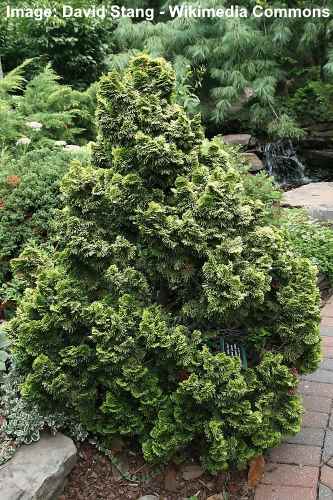
Hinoki cypress cultivar ‘Nana’ is a dwarf ornamental evergreen conifer tree for small spaces
The small Hinoki cypress tree ‘Nana’ is a slow-growing coniferous for landscaping small yards and compact gardens. Thriving in full sun to partial shade, the small Hinoki cypress tree has a compact, rounded shape, scale-like deep green leaves, and brown seed-bearing cones.
The slow-growing Hinoki cypress tree ‘Nana’ tree grows 1 to 3 ft. (0.3 – 1 m) tall and 4 ft. (1.2 m) wide.
Small Hinoki cypress trees are the ideal decorative trees for planting in rock gardens, mixed borders, or as foundation plants in a front yard. The slow-growing tree is also suitable for planting in containers on balconies, patios, or beside door entrance-ways.
Small Hinoki cypress trees are suitable for growing in USDA zones 4 to 8.
Blues Weeping Colorado Spruce Tree (Picea pungens ‘The Blues’)
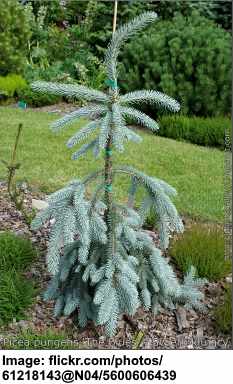
The blues weeping Colorado spruce is a dwarf narrow tree with stunning silvery evergreen foliage
‘The Blues’ conifer cultivar is a species of spruce tree that doesn’t grow more than 6 feet tall. The outstanding evergreen tree identification feature is its distinctive silvery blue-green needles on branches that droop to create a weeping effect. These drooping branches eventually grow horizontally along the ground.
‘The Blues’ species of spruce tree has a slow growth habit, and the ornamental tree eventually grows up to 6 ft. (1.8 m) tall and wide. Its columnar habit and evergreen foliage make it an ideal focal point in a sunny landscape.
Other ornamental features of the blue spruce are its lush blue spring foliage, cylindrical spruce cones, weeping habit, and tolerance to drought and acidic soils.
You can plant ‘The Blues’ weeping Colorado spruce tree in USDA growing zones 2 to 8.
Small Balsam Fir Tree (Abies balsamea ‘Nana’)

The small balsam fir ‘Nana’ is one of the most popular compact dwarf fir trees
The balsam fir is a slow-growing small evergreen tree that only grows 2 ft. (0.6 m) tall. This sun-loving evergreen tree is perfect for planting where space is limited or to add color and texture to a landscaped garden.
An ornamental feature of the popular balsam fir is its dense, compact growth globose habit and soft, dark green fir needles that emit a pleasant fragrance.
The small balsam fir tree grows 1 to 2 ft. (0.3 – 0.6 m) tall and wide. The small conifer is suitable for planting as an accent plant, foundation planting, or as a container plant on your patio or balcony.
Small balsam fir trees are suitable for growing in USDA zones 3 to 6.
Small Serbian Spruce Tree (Picea omorika ‘Nana’)
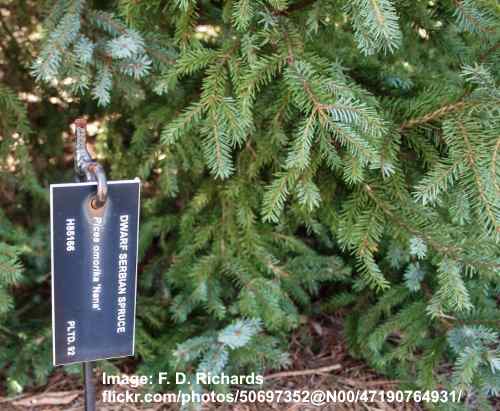
The dwarf cultivar of the Serbian spruce is an excellent evergreen tree to plant when landscaping any large or small garden
The small Serbian species of spruce tree ‘Nana’ is a compact evergreen tree. Its low height and compact growth suit containers and small gardens. The dwarf ornamental evergreen tree is identified by its dense, conical growth, dark green flat needles, and branches growing in a spiral pattern around the trunk. Its drooping egg-shaped cones emerge purple and turn brown as they mature.
The small Serbian spruce cultivar ‘Nana’ grows 4 to 8 ft. (1.2 – 2.4 m) tall and wide. Its slow growth rate, dark brown peeling bark, and glossy green, soft needle leaves make it an excellent choice for landscaping small gardens or growing in containers.
The tree’s unique blue-green color and dense foliage mean it’s an attractive addition to rock gardens, borders, or as a specimen plant.
The small Serbian spruce tree ‘Nana’ is suitable for growing in USDA zones 4 to 7.
Strawberry Tree (Arbutus unedo)
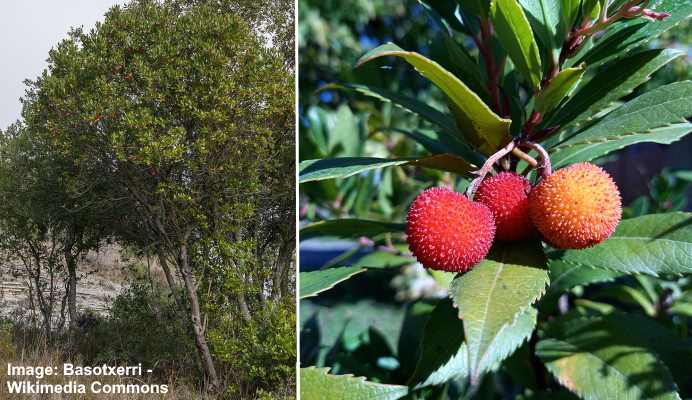
The small evergreen strawberry tree has red spiky edible fruit and attractive bark
The strawberry tree is an ornamental evergreen tree, perfect for landscaping a compact backyard. The evergreen broadleaf tree produces clusters of urn-shaped white flowers followed by rounded, colorful fruit. The ball-like fruits look like small strawberries and ripen in winter. They taste like a blend of strawberry and kiwifruit, and you can eat them raw or make them into jam.
The ornamental strawberry tree is suitable for growing small to medium-sized gardens in USDA zones 7-10. The decorative tree grows 6 to 15 ft. (1.8 – 4.5 m) tall and wide.
Perfect for smaller yards, other decorative features of the small strawberry tree are its brownish bark that peels to reveal cinnamon-colored inner bark.
Small Japanese Black Pine (Pinus thunbergii ‘Kotobuki’)
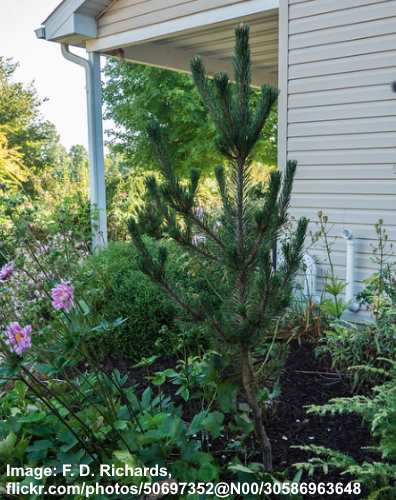
The small and slow growing Japanese black pine tree makes an excellent choice for landscaping compact spaces
The Japanese black pine cultivar ‘Kotobuki’ is a small, sun-loving evergreen tree with a unique and striking appearance. The small tree has twisted, prickly dark-green pine needles, an irregular branching habit, and small conical pine cones measuring up to 1” (2.5 cm) tall.
The compact tree has a growth rate of 1” to 6” (2.5 – 15 cm) per year and eventually matures at 5 ft. (1.5 m) after ten years. Its easy-care nature and compact shape make it an ideal choice for small gardens and landscapes. The Japanese black pine ‘Kotobuki’ is suitable for growing in USDA zones 5 to 8.
Pencil Point Juniper (Juniperus communis ‘Compressa’)
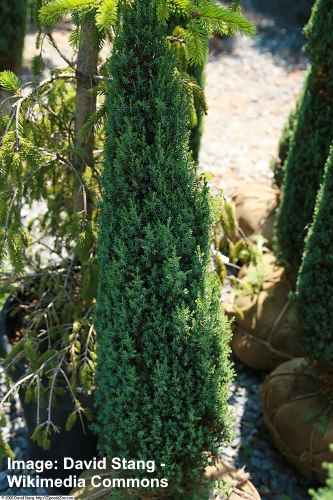
The pencil point juniper is a great small evergreen tree for narrow spaces in your garden
The ‘Pencil Point’ juniper is a small evergreen tree with a distinctive slender, columnar form. The small juniper tree is identified by its densely packed blue-green juniper needles, evergreen foliage, and upright cone shape resembling a long slender exclamation mark. The compact, low-maintenance coniferous tree grows up to 3 ft. (1 m) tall.
Its slender shape makes it an excellent choice for narrow spaces or as an accent plant. The ‘Pencil Point’ juniper thrives in full sun and well-drained soil. The drought-tolerant tree is easy to maintain and requires little pruning. You can plant pencil point juniper in a mixed border or as a privacy screen.
The ‘Pencil Point’ juniper is suitable for growing in USDA zones 2 to 6.
Upright Japanese Plum Yew (Cephalotaxus harringtonia ‘Fastigiata’)

The Japanese plum yew ‘Fastigiata’ has columnar growth habit
The Japanese plum yew ‘Fastigiata’ is a sun-loving evergreen tree with a distinctive upright columnar form. Ideal for small backyards and front-of-the-house planting, the slender evergreen has glossy dark green needle leaves growing on branches almost horizontal to the main trunk. It’s a great choice for planting in tight, narrow small spaces.
The Japanese plum yew ‘Fastigiata’ is a slow-growing yew that grows less than 10 feet tall and only 5 ft. (1.5 m) wide.
This plum yew tree thrives in full sun or partial shade and prefers well-draining soil. This low-maintenance tree is perfect for planting in a mixed border or as a specimen plant. Its unique shape and texture make it a great addition to any garden.
Upright Japanese plum yew is suitable for growing in USDA zones 6 through 9.
Small Japanese Euonymus (Euonymus japonicus)
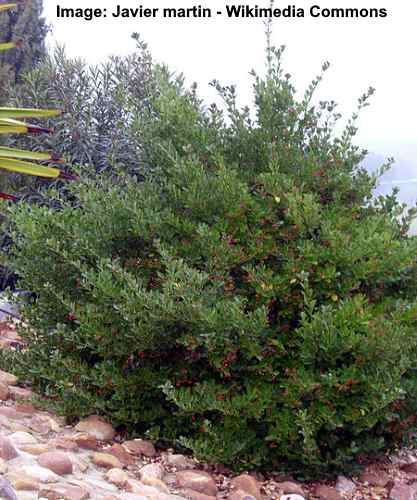
Japanese euonymus is a small tree with various cultivars
Also called the Japanese spindle tree, the small evergreen tree is ideal for planting as a hedge or borders around a small front or backyard. The broadleaf evergreen tree thrives in full sun or heavy shade and grows 10 to 15 ft. (3 – 4.5 m) tall and 5 to 8 ft. (1.5 – 2.4 m) wide. Its glossy green oblong leaves measure 1” to 3” (5 – 10 cm) long.
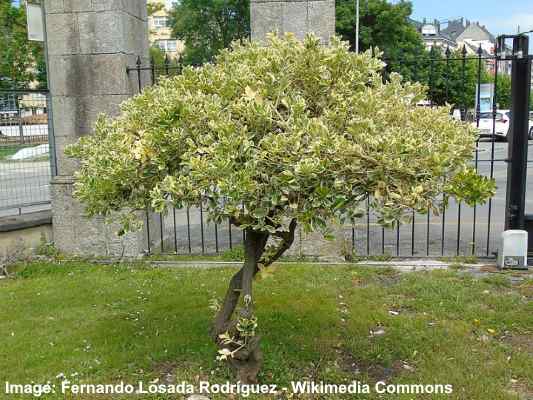
Euonymus japonicus ‘Aureo-marginatus’ has variegated leaves and is shaped in this picture like a small tree
In full sun or partial shade, you can plant the easy-care Japanese spindle tree as a hedge, foundation planting, or as a specimen plant. The small evergreen tree is suitable for growing in USDA zones 6 to 9.
Miniature Common Juniper ‘Gold Cone’ (Juniperus communis ‘Gold Cone’)

Juniperus communis ‘Gold Cone’ is a dwarf narrow evergreen tree with dense gold-green foliage in summer
The miniature common juniper ‘Gold Cone’ is a compact, sun-loving, evergreen tree. It is ideal for planting in tight corners or landscaping small sunny yards. The ornamental features of this upright juniper are its dense, soft foliage, columnar shape, and bright gold colors in spring that turn blue-green by winter.
The small juniper tree grows 3 to 5 ft. (1 – 1.5 m) tall and 2 ft. (0.6 m) wide. You can plant the attractive tree in sunny rock gardens, mixed borders, or as a specimen or foundation planting.
You can grow miniature common juniper ‘Gold Cone’ in USDA zones 3 through 8.
Green Arrow Weeping Alaska Cedar (Chamaecyparis nootkatensis ‘Green Arrow’)
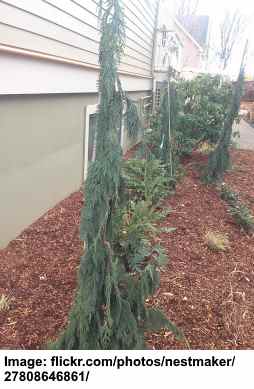
The ‘Green Arrow’ weeping Alaska cedar is a narrow evergreen slow growing tree with drooping branches
The ‘Green Arrow’ weeping Alaska cedar tree is one of the most stunning landscaping trees for compact front or backyards. The easily identifiable features of the evergreen tree are its narrow, columnar habit with drooping branches and soft, feathery foliage that stays green year-round. Its slender growth means it’s an excellent choice to make a focal point in smaller landscapes.
The ‘Green Arrow’ weeping Alaska cedar is a relatively large evergreen tree. However, its slow growth rate means it takes ten years to grow 20 ft. (6 m) tall and 2 ft. (0.6 m) wide. The Alaska cedar performs well as a specimen plant thanks to its weeping shape.
The ‘Green Arrow’ weeping Alaska cedar is suitable for planting in USDA zones 4 through 8.
‘Little Gem’ Dwarf Southern Magnolia (Magnolia grandiflora ‘Little Gem’)

‘Little Gem’ is a dwarf cultivar of Southern magnolia (Magnolia grandiflora) with evergreen foliage and white flowers
The southern magnolia tree ‘Little Gem’ is a small, evergreen tree species with large, fragrant white flowers and narrowly columnar habit. The decorative flowering tree is identified by its glossy, dark green leathery leaves and brilliant white flowers. Perfect for smaller gardens, the southern magnolia grows 15 to 20 ft. (4.5 – 6 m) tall and 10 ft. (3 m) wide.
The ‘Little Gem’ magnolia thrives in full sun to partial shade and is a perfect specimen plant or small tree in a garden landscape. The fragrant flowers bloom from late spring until early summer, attracting pollinators and adding a sweet fragrance to the garden.
‘Little Gem’ dwarf southern magnolia evergreen species is suitable for growing in USDA zones 7 to 9.
Related articles:
- Small Flowering Trees – Identification Guide
- Columnar Trees for Small Gardens
- Small or Dwarf Weeping Trees for Landscaping
